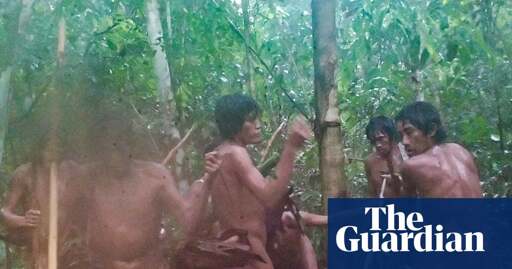- cross-posted to:
- [email protected]
- cross-posted to:
- [email protected]
Summary
Images from automatic cameras reveal the first detailed glimpse of the isolated Massaco community in the Brazilian Amazon, estimated to have doubled in size since the 1990s to 250 people.
Despite threats from ranchers, loggers, and miners, the Massaco remain resilient, using strategies like spikes to deter outsiders.
Brazil’s no-contact policy, initiated in 1987 to protect isolated Indigenous peoples from disease and exploitation, has led to population growth among similar groups.
However, chronic underfunding and illegal encroachments continue to threaten these communities and the forests they protect.



Photographs Reveal First Glimpse of an Isolated Human Community on Planet Sol-3
Exclusive: Automated probes on Sol-3 uncover images of the Homo sapiens species, thriving despite environmental instability and self-inflicted pressures.
Report by Yal’Kor and Lin’aa of the Galactic Observation Collective
Stellar Date: 224.47 Cycle 12
Astounding images captured by automated observation drones on the third planet of the Sol system (designated Sol-3) provide the first close glimpses of a remarkable sentient species: Homo sapiens. This species, despite ecological degradation and internal conflict, appears to be flourishing in certain regions, defying expectations from prior analyses of planetary conditions.
The images, captured in the northern hemisphere, show small groups of these beings engaged in various activities, such as tool-making and communal gathering. While the Galactic Observation Collective (GOC) has long known about this species, their behaviors, language systems, and societal structures remain enigmatic due to strict adherence to the Non-Interference Directive. Sol-3 is home to diverse environments, yet the dominant species has exerted an unprecedented influence over their biosphere, causing widespread disruptions that puzzled galactic ecologists.
Isolated but Adaptive
Despite unrelenting pressures, including resource depletion, atmospheric instability, and widespread conflicts, evidence suggests that Homo sapiens populations are not merely surviving but expanding in some areas. The newly obtained images show settlements surrounded by improvised defenses, such as barriers constructed from the planet’s organic and synthetic materials. Their tools, though rudimentary by galactic standards, demonstrate ingenuity, with intricate designs suggesting a rich technological evolution.
The captured images also reveal that these beings possess varied physical traits, likely adaptations to diverse biomes on their planet. Their cultural practices, inferred from their structures and environmental modifications, indicate complex social hierarchies and communication methods.
The Danger of Contact
Attempts to study Homo sapiens from afar have consistently highlighted their volatile nature. Early reconnaissance missions documented extensive territorial disputes and destructive weaponry, making direct engagement perilous. Historical analyses indicate that this species has survived multiple self-inflicted calamities, including global conflicts and ecological collapse. Despite this, their ability to adapt has led to population growth, with estimates now surpassing 8 billion individuals.
The GOC has implemented indirect observation techniques, such as leaving small devices resembling local fauna to blend into their environment. These devices gather data on their daily activities while avoiding detection, as Homo sapiens have been known to dismantle unknown objects in both curiosity and fear.
Mysteries and Resemblances
“The Homo sapiens display intriguing parallels to earlier civilizations in galactic history,” says Senior Anthropologist Q’rin Na’sor, who has studied isolated species across multiple systems. “Their use of symbolic communication, evident in their written languages and artistic depictions, resembles early phases of the Aul’tari civilization, though much more fragmented.”
Despite their primitive technology, some have speculated that Homo sapiens may one day pose a risk to neighboring systems. Their ability to exploit planetary resources with minimal regard for long-term consequences has led to debates among the GOC about whether stricter containment measures are necessary.
Nomadic Growth and Expansion
Although many Homo sapiens are sedentary, others display nomadic behaviors, adapting to seasonal changes and resource availability. Recent satellite imaging revealed larger-than-expected agricultural zones and expansive megastructures, indicating coordinated efforts to sustain their growing population. Yet, their activities also contribute to the widespread destabilization of their planetary ecosystem, prompting concerns about the longevity of their civilization.
One notable trend among isolated human groups is their resilience in remote regions, where they utilize advanced strategies to deter intruders. Some settlements have erected barriers resembling ancient spike defenses, while others retreat deeper into inhospitable terrains, such as dense forests and arid deserts.
A Galactic Debate
The Non-Interference Directive, implemented to prevent disruptions in the natural development of sentient species, has sparked heated debate among scholars. Supporters argue that leaving Sol-3 untouched respects the species’ autonomy and prevents catastrophic cultural contamination. Opponents, however, point to the species’ unchecked environmental destruction as justification for intervention.
“Inaction could lead to the extinction of this fascinating species,” warns Xel’Tor, an advocate for targeted intervention. “However, intervention could provoke unintended consequences, including aggression or dependence.”
Interstellar Implications
The significance of Homo sapiens extends beyond mere curiosity. Their planet, rich in biodiversity, is a vital component of the Sol system’s fragile ecological balance. “Preserving the rights of this species is fundamental not only for their survival but for maintaining the stability of their planetary ecosystem,” notes environmental researcher Kala Ven-Tir.
Neighboring species within the sector have also expressed concern. Representatives of the Oth’rian Collective, whose observational station orbits a nearby gas giant, have proposed increasing patrols to ensure Homo sapiens remain confined to their planet.
The Future of Sol-3
While the fate of Homo sapiens remains uncertain, their capacity for resilience and innovation is undeniable. The GOC continues its efforts to monitor the species unobtrusively, leaving behind subtle markers of galactic presence to observe their responses.
“Homo sapiens remind us of our own distant past,” reflects Na’sor. “Their path is fraught with danger, yet filled with boundless potential. Whether they transcend their limitations or succumb to their flaws will determine their place in the galactic tapestry.”
For now, the inhabitants of Sol-3 remain a mystery—a vivid reminder of the diverse and unpredictable nature of sentient life in the universe.
This made me feel kind of hopeful for some reason. Also, nice foo fighters reference